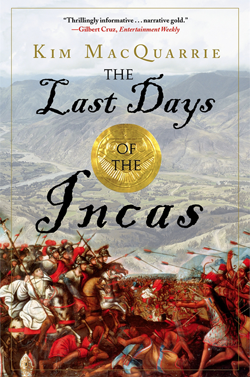Timeline for The Last Days Of The Incas
1532
Fifty-four-year-old Francisco Pizarro, four of his brothers, and 163 Spanish conquistadors land in Peru and capture the Inca emperor, Atahualpa.
1533
Atahualpa fills a room full of gold as a ransom but the Spaniards execute him anyway. Pizarro captures the Incas’ capital of Cuzco and installs Atahualpa’s 17-year-old brother, Manco Inca, as the new Inca emperor–a “puppet king.”
1536
Twenty-two-year-old Gonzalo Pizarro steals Manco Inca’s wife, Cura Ocllo. Manco Inca rebels, gathers 200,000 warriors, and surrounds Cuzco. Francisco Pizarro’s youngest brother, Juan, is killed. The Inca general Quizo Yupanqui wipes out five Spanish relief forces and then attacks the Spanish coastal city of Lima. Quizo’s attack fails and the Inca general is killed.
1537
Manco Inca suspends the siege of Cuzco and abandons the Andes. He and his followers found in the Amazon jungle a new capital named Vilcabamba. Manco begins a classic guerrilla war and renders entire portions of the Andes too dangerous for the Spaniards to enter.
1541
Francisco Pizarro is murdered by his own men. He has ruled the Inca Empire for a mere nine years.
1572
The fall of the Inca empire: After 37 years of guerrilla warfare, the Spaniards mount a large expedition, head down the eastern side of the Andes, and sack Vilcabamba. The final Inca emperor–Tupac Amaru–is captured and is taken to Cuzco in chains where he is beheaded. Thus ends ninety years of Inca rule over the largest empire the New World has ever known.
1572-1911
The Incas’ guerrilla capital of Vilcabamba becomes lost to history. Gradually, it becomes a myth, a legend–similar to the Greek legend of Troy. Had Vilcabamba really ever existed? No one really knows.
1911
A 35-year-old American Yale history professor named Hiram Bingham begins to search for the lost Inca capital of Vilcabamba. One week into his expedition, he stumbles upon the ruins of Machu Picchu. Bingham declares that he has discovered Vilcabamba–Manco Incas’ lost rebel capital.
1914-1915
Bingham’s third and final trip to Machu Picchu. Bingham ships more than 5000 artifacts he and his team discovered at Machu Picchu to Yale University’s Peabody Museum. Bingham signs a contract with the Peruvian government stating that the artifacts are to be returned upon Peru’s request. Bingham goes on to become a Governor and U.S. Senator.
1956
Hiram Bingham dies, still claiming that Machu Picchu is Vilcabamba–the lost rebel capital of the Incas. But Bingham is wrong.
1964-1965
The American explorer, Gene Savoy, discovers the real location of Vilcabamba, buried in thick Amazonian jungle. Machu Picchu, it turns out, was really a royal retreat for the founding Inca emperor.
2002
Yale University sponsors a large traveling exhibit in the United States of Hiram Bingham’s Machu Picchu artifacts. The exhibit is visited by more than two million Americans and makes millions of dollars.
2002-2007
The Peruvian government urges Yale to return Bingham’s Machu Picchu artifacts to Peru. The government threatens to sue Yale in order to secure the artifacts’ return before the 100th anniversary of the discovery of Machu Picchu.
2011
2011 will be the one hundredth anniversary of Hiram Bingham’s discovery of Machu Picchu. Peru hopes that all of Hiram Bingham’s Machu Picchu artifacts will be returned to Peru by this time.

